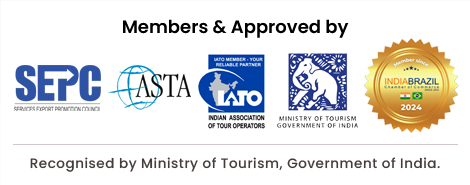T he dramatic landscape of Bhutan flourishes with beauty and color. Subtropical plains, the steep mountains, and verdant valleys create its topography. This Buddhist Kingdom is nestled on the eastern Himalayan edge. There are Monasteries and fortresses or Dzongs in every turn of the rolling mountains. Bhutan is truly a mystical place wedged between two giant nations, India and China. The quaint nation is best known for its unique philosophy of living that makes it unparalleled. With less than a million population, the tiny nation has big ideas. Bhutan is the only country to measure its wealth in terms of the Gross National Happiness of its people.
Foreigners visiting Bhutan pay a minimum tariff, which may seem a lot, but it covers everything - food, accommodation, transport, and a guide. In addition, a traveler does not have to be in a group, making Bhutan a budget-independent travel destination. The country is like no other. Cultural and environmental preservation goes hand in hand in Bhutan. By law, at least 60% of Bhutan must be forested for all future generations, and presently, it stands above 70%. Bhutan is quite fascinating as it is not only carbon neutral, but it absorbs more carbon than it emits! Besides, it has deep roots in Buddhist culture, with monks performing prayers day and night and people celebrating Buddhist traditions with fun and enthusiasm. The blend of ancient and modern makes Bhutan endlessly captivating.
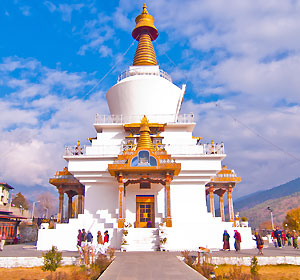
Thimphu is the capital city, a blend of modern biases and harmonious traditions. It has restaurants, internet cafes, nightclubs, shopping centers, ATMs, and foreign stock exchanges. But the traditional values are carefully preserved amidst the signs of modernization.
Thimphu is the commercial hub of Bhutan, the center of Government administration. Plus, it is home to famous Buddhist sites. The milky white edifice Chorten Memorial is a revered Buddhist shrine. The golden pinnacled building is dedicated to the third king of Bhutan, Jigme Dorji Wangchuck. The massive fortress and monastery Tashichho Dzong is a feast to the eyes with gold-leaf roofs. It has been acting as the Government seat since 1952 and now is the King's office, secretariat, and office of other ministries.
A city of 100,000 inhabitants, Thimphu has no traffic signal. A few years ago, traffic congestion was an unknown term in the country. Police officers control the traffic with exaggerated hand motions from decorated booths.
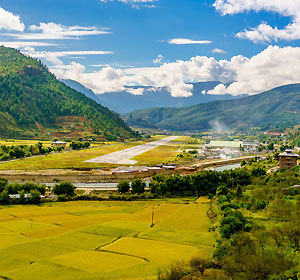
The vast and verdant Paro Valley is the historic center of Bhutan. Many historical and cultural landmarks such as the National Museum, Paro Dzong, the Taktsang Monastery, and the Cheri Lang monastery are spread across Paro Valley.
Recognized as the most beautiful place in Bhutan, Paro offers nature at its best amid a peaceful environment. You can experience the contrast between traditional wooden and concrete structures across the valley.
The Takstang's Monastery, also known as Tiger's Nest, hangs at 3,120 meters. The monastery, also named Guru Rinpoche, is believed to have landed on the back of a tiger. Hanging at the top of a cliff, Tiger's Nest offers exciting trekking opportunities in Bhutan.
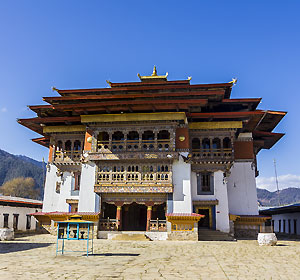
At Gangtey, the green pasture extends beyond the vision, and there is no tree to obstruct the sight. This plain and verdant valley at an elevation of 3,000 meters is a surprising beauty in Bhutan. Gangtey is among the few glacial valleys in Bhutan located on the western slopes of the Black Mountains. The conserved area is the winter home of the endangered black-necked crane.
The Gangteng Monastery perched on top of a small hill rising from the valley floor adds awe to the sight. It is the biggest Nyingmapa monastery in Bhutan, and the people of the village take care of the gompa.
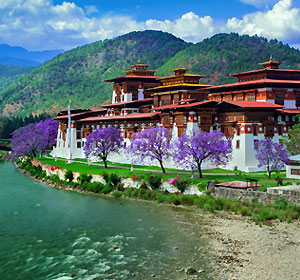
Located within 2 hours of drive from Thimphu, Punakha is the ideal place to explore the plentiful wildlife of Bhutan. The main highlight of the rich birdlife is the White-Bellied Heron, Asia's largest of its kind. Unfortunately, only a few hundred of this endangered class are left alive. Also, many migratory aquatic birds make the valley their winter home. Among bigger animals, Takins are found in the northern end of the region. This is the National Animal of Bhutan, and during winter, they come to the lower ground.
Punakha is also the cultural hub of western Bhutan. The first King Dzong was crowned here in 1907, and since then, all crowning ceremonies have been held here. The valley is home to many temples, farmhouses, and viewpoints. Khamsum Yueling has some exquisite wall frescoes, making Punakha a traveler's delight. And if you are into outdoor activities, Punakha is a popular spot for a day hiking trip in Bhutan.
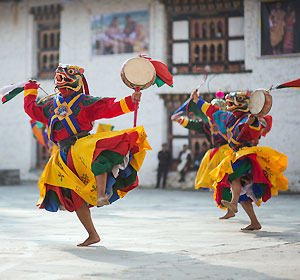
This small town takes visitors to a different world of peaceful beauty. Situated atop a hill, Mongar is eastern Bhutan's trade and travel hub. The place is famous for weavers and textiles producing world-famous products.
The place is spectacular, with deep gorges, stark cliffs, and bushes of conifer inhabited by a population of about 3000 people. The clean and wide streets are lined with traditionally painted stone buildings with wooden facades and verandas. It is delightful to explore the place on foot amid lovely weather.
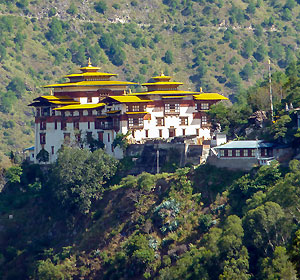
The largest district in Bhutan, Trashigang, is settled in the eastern part of the country. Once the center of a busy trade route with Tibet is now a marketplace for the semi-nomadic people from Merak and Sakteng, whose costumes are unique in Bhutan. Trashigang is the junction of the east-west highway with the road connecting Samdrup Jongkhar and the Indian State of Assam. If you are an architecture lover, you will explore the traditional architecture of this quaint town on foot.
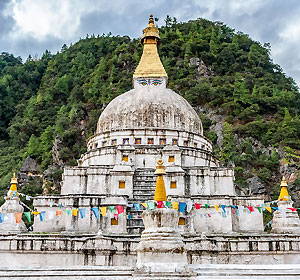
This culturally diverse place spans over 437 sq km of subtropical highland forests. Trashiyangtse is one of the most beautiful destinations in Bhutan, with immense natural, historical and cultural resources. One of the major attractions of the place is Gom Kora Temple, located between Trashiyangtse and Trashigang. The temple is associated with Guru Padmasambhava, the legendary Buddhist master of the 8th-century.
Another famous attraction is Zorig Chusum, the school of the 13 crafts now a Bhutan government enterprise.
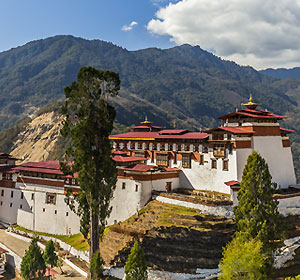
Bumthang, consisting of four smaller valleys, Tang, Ura, Choekhor, and Chumey, has a distinct charm. It is a spiritually rich place and is home to the great Buddhist teacher Pema Linga.
The fertile land is covered by green plantation buckwheat, rice, and potatoes. You will also view apple orchards and dairy farms that are common sights here. This charming region is one of the most tranquil places to visit in Bhutan.
USEFUL INFORMATION
A valid passport with a validity of six months is required for Bhutan. Guests must obtain a visa clearance prior to the visit. Visa applications are processed through an online system. Licensed Bhutanese tour operators can apply for the visa directly or through a foreign travel agent. Indian Holiday assists their guests to obtain the visa easily.
Banks and Business Hours
Some of the well operational banks in Bhutan are the Bhutan National Bank, Bank of Bhutan Limited, the Druk PNB and the Tashi Bank. Internet banking, traveler's cheque withdrawal, and currency exchange are available here.
Banks remain closed on Sunday and Saturday afternoon. The business hours are from 9 AM Bhutan Standard Time to 5 PM.
Banks remain closed on Sunday and Saturday afternoon. The business hour is from 9 AM Bhutan Standard Time to 5 PM.
Local Time: GMT + 6
Bhutan is a year-round destination. But the best time for a trip to Bhutan is from March to May and September to November. This time pleasant weather and popular festivals make for peak tourist season in Bhutan.
Mid-November to mid-March marks winter when the temperature ranges from 0-degree Celsius to 15 degrees Celsius. From June to August, Bhutan experiences the monsoon season.
All foreign travelers must submit their details in the prescribed customs declaration form on arrival at the Paro International Airport. In addition, guests are advised to be careful about purchasing any old or religious items. Customs authorities won't allow you to take such things out of Bhutan unless a non-antique tag is attached.
BAGGAGE ALLOWANCE
The standard free allowance while flying in the Economic class is 20 kg, and for First Class, it is 30 kg.
AIRPORT DEPARTURE TAX
Airport departure tax is usually included in international tickets, and you do not have to pay at the airport.
The national currency of Bhutan is the Ngultrum (Nu). Ngultrum is divided into 100 smaller units called chhertum. Apart from this, the Indian rupee is accepted as legal tender in Bhutan. But remember, only INR (Indian Rupees) denominations of 100 and 500 are accepted in Bhutan. Most hotels and shops receive other denominations like INR 2000, but not all.
ATMs are across all main towns in Bhutan, where you can withdraw money using a Visa or Mastercard.
It is not mandatory but advised to take tetanus, typhoid, and hepatitis vaccination before the trip. In addition, a yellow fever vaccination certificate is required if you come from a country with a risk of yellow fever transmission.
Free and proper health service is available in Bhutan, especially in Thimphu and other prime cities that have well-equipped hospitals.
Electricity is available in all major cities with the power of 220/240 volts. You will get round hole two-pin and three-pin power outlets to charge your mobile and other purposes.
The national language of Bhutan is Dzongkha, which is the most widely spoken in the country. Bhutanese also speak English, which makes communication with travelers very easy.
Bhutan is famous for silk and hand-woven textiles. In addition, hand-made wooden, bamboo, and paper showpieces, baskets, and canes are famous here. Also, the best things to buy in Bhutan are masks made from various animal skin, Buddhist Thangka paintings, and colorful and creative postage stamps. Also, there are many handicraft shops in Thimphu and other major towns where you can explore the traditional items, including finely crafted silver products.
Chili and spices are the main ingredients of the distinct Bhutanese cuisine. The central part of almost all Bhutanese meals is rice. The rice is eaten with meat or vegetables. Pork, beef, and chicken are eaten most often in Bhutan. The commonly eaten vegetables are Spinach, tomatoes, pumpkins, turnips, onions, radishes, river weed, and green beans.
The most popular Bhutanese dishes are Ema Datshi, Momos, Phaksha Paa, Jasha Maru, Red Rice, etc.


